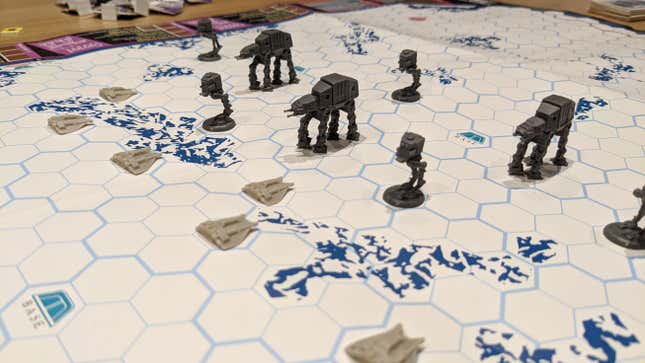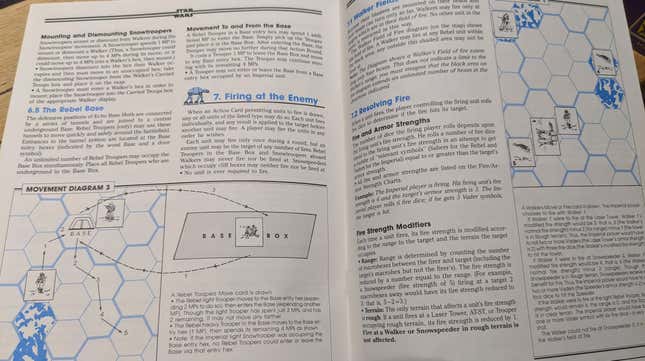Let’s go back in time. Not to 1980, when Empire Strikes Back came out, that’s too far. We’re going to 1988, when West End Games, a company famous at the time for its RPGs and hardcore wargames, released a two-player board game called Assault on Hoth, which I have just played in 2020 and will now tell you is surprisingly good!
Assault On Hoth wasn’t West End’s first or only Star Wars game. The company’s RPGs were pretty big at the time—during probably the lowest ebb of Star Wars’ popularity. They released stuff like a weird singleplayer wargame called Battle For Endor, where you battle an AI-controller Imperial force, and Star Warriors, a hilariously over-complicated predecessor to the far more excellent X-Wing.
I’ve played both of those other board games, and from my coddled 21st-century vantage point, hated them both. Assault On Hoth, however, hits a wonderful sweet spot, where it’s simple and smart enough that most casual contemporary gamers could sit down with this and be fine, while also retaining enough wargaming complexity to give its movement and combat systems some meat.
It’s a hex-based wargame where the objective remains the same every time you play. The Empire has to march across the map and blow up the Rebel base’s shield generator, while the Alliance have to scramble and hold them off long enough for some transports to get away. This greatly limits replay value, since the narrow map only allows for so many tactics, but swapping sides did present a different enough approach that it was worth a few plays through at least.
The Imperial player can rely on brute strength and overwhelming numbers, while the Rebels have speed, manoeuvrability and some tacked-on force powers courtesy of Luke Skywalker’s presence as one of the Snowspeeder pilots. This is a fairly accurate approximation of the on-screen match-up, which goes well past the setting and into most of the game’s systems as well. You can tell that a company used to recreating real battles knew how to size up a fake one and apply the same logic.

A lot of games tear the guts out of the battle by trying to make both sides more equal, make it a fairer fight, but I love here how your progress through the battle here feels so close to the on-screen experience. There’s an initial sense of dread as you lay the units out on the map and see the Imperial firepower on array, a rush as the Rebel’s snowspeeders soar across the land to engage, excitement as the fighters do cool shit like harpooning giant walkers, and then despair as it becomes clear the Empire is just too much and the Rebels are going to have to bust their asses just to get out of this alive.
Assault On Hoth’s gameplay rests on two basic pillars. The first is that the players don’t take sequential turns; instead there’s a large deck of action cards, each one allowing a single type of unit to move, fire or both. While the overall contents of the deck are “fair”, the way they’re drawn can wildly vary. If the Rebel player gets to move four times before the Imperial player draws a card, because the first four cards all related to Rebel units, tough shit!
The idea here is that because you go through the deck a lot during a game, both players end up getting the same number of turns overall, it’s just the order you get to perform them can change. And it can help get a real good flow going; walkers and speeders get a lot more turns than other units, being the stars of the show, and if you draw two speeder cards in a row you really do feel like these nimble little craft are zipping over the battlefield towards their slow, lumbering targets.
The game’s other pillar is that combat is more than just registering hit points until something dies. There’s a two-tiered system when it comes to damage; most units, from troops to turrets, are simply destroyed instantly if they’re hit, but speeders and walkers take specific damage. Combat involves rolling one set of dice to see if you score a hit, and if you do, you then roll for numerical damage to see what kind of hit it was, which can be anything from a speeder’s gunner being killed (RIP Dak) to a walker’s legs being crippled by turret fire.
Sure, once you score enough hits these units will be destroyed, but the staggered and varied way you can deal damage leading up to that threshold is cool, and again, very in keeping with a battle where some of the most memorable moments include... gunners being killed and walkers having their legs taken away.
Things can get too thematic at times though. When I said the speeders and walkers were the stars, they’re more than that. They’re the only viable units in the entire game outside of an occasionally useful turret. The action deck is full of moves for infantry who are rendered almost pointless by the pace and strength of the battle going on above them.
The light and heavy ground forces end up just taking up space on the board and slowing everything down, to the point where in one game once the walkers were closing in on the shield generator, both myself and my opponent were skipping infantry turns altogether since they were so useless. (The one exception to this being the Rebel player’s ability to “teleport” around the map using underground tunnels, which made their heavy troopers slightly more useful.)
That was just an annoyance, though. The only actual issue I had with the game being how it ends. Alongside the action deck is another collection of cards called the event deck. Twice per action deck you’ll be asked to draw from this, and events allow for stuff like reinforcements or cards that grant one player bonus effects. Also included are five “transport is away” cards, and every time one of those is drawn they’re given to the Rebel player to symbolise a transport full of people/stuff escaping Hoth.

In my first game as the Rebel player I drew all five action cards before we were halfway through the deck, and that was that. That’s the Rebel player’s victory condition. Hold out until all five of those cards were drawn. It suuuuuuucked, and just completely undermined what had been a thrilling cat-and-mouse game. What’s the point in building up long-term strategies if unlucky card draws can just fuck them over entirely?
Conversely, had those cards been staggered until the end of deck, that would have made things almost impossible for the Rebel player who can never stop the Empire, just hold them off. It’s wild that the designers couldn’t think of a better timing mechanic that just, “Well let’s just draw cards whoopsee!”, but that could also just be me being a pampered 21st-century asshole.
Assault on Hoth is 32 years old, made by a serious wargaming company. This whole experience of sitting down with it was as much as an exercise in game design time capsuling as it was approaching a game I’d never played, and going into this I expected a lot worse, and rougher edges than a busted ending mechanic.
Stephen has written previously about video gaming’s decades-long attempt to do The Battle Of Hoth justice, which is appropriate because the copy I played was actually Stephen’s from when he was a kid, which he sent to me so I could kick its tyres.
And I think that, despite its age, it does one of the best jobs I’ve ever seen of getting Hoth just right. From the pacing to the way it sticks so close to the theme, it does a fantastic job of taking such a lop-sided battle and making a fast, fun game out of it.

